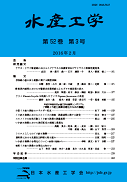Volume 44, Issue 2
Displaying 1-9 of 9 articles from this issue
- |<
- <
- 1
- >
- >|
-
Article type: Article
2007Volume 44Issue 2 Pages 79-84
Published: November 15, 2007
Released on J-STAGE: September 01, 2017
Download PDF (719K) -
Article type: Article
2007Volume 44Issue 2 Pages 85-90
Published: November 15, 2007
Released on J-STAGE: September 01, 2017
Download PDF (800K) -
Article type: Article
2007Volume 44Issue 2 Pages 91-100
Published: November 15, 2007
Released on J-STAGE: September 01, 2017
Download PDF (1618K) -
Article type: Article
2007Volume 44Issue 2 Pages 101-111
Published: November 15, 2007
Released on J-STAGE: September 01, 2017
Download PDF (1515K) -
Article type: Article
2007Volume 44Issue 2 Pages 113-118
Published: November 15, 2007
Released on J-STAGE: September 01, 2017
Download PDF (576K) -
Article type: Article
2007Volume 44Issue 2 Pages 119-125
Published: November 15, 2007
Released on J-STAGE: September 01, 2017
Download PDF (1292K) -
Article type: Article
2007Volume 44Issue 2 Pages 127-138
Published: November 15, 2007
Released on J-STAGE: September 01, 2017
Download PDF (1883K) -
Article type: Article
2007Volume 44Issue 2 Pages 139-145
Published: November 15, 2007
Released on J-STAGE: September 01, 2017
Download PDF (969K) -
Article type: Article
2007Volume 44Issue 2 Pages 147-152
Published: November 15, 2007
Released on J-STAGE: September 01, 2017
Download PDF (930K)
- |<
- <
- 1
- >
- >|
